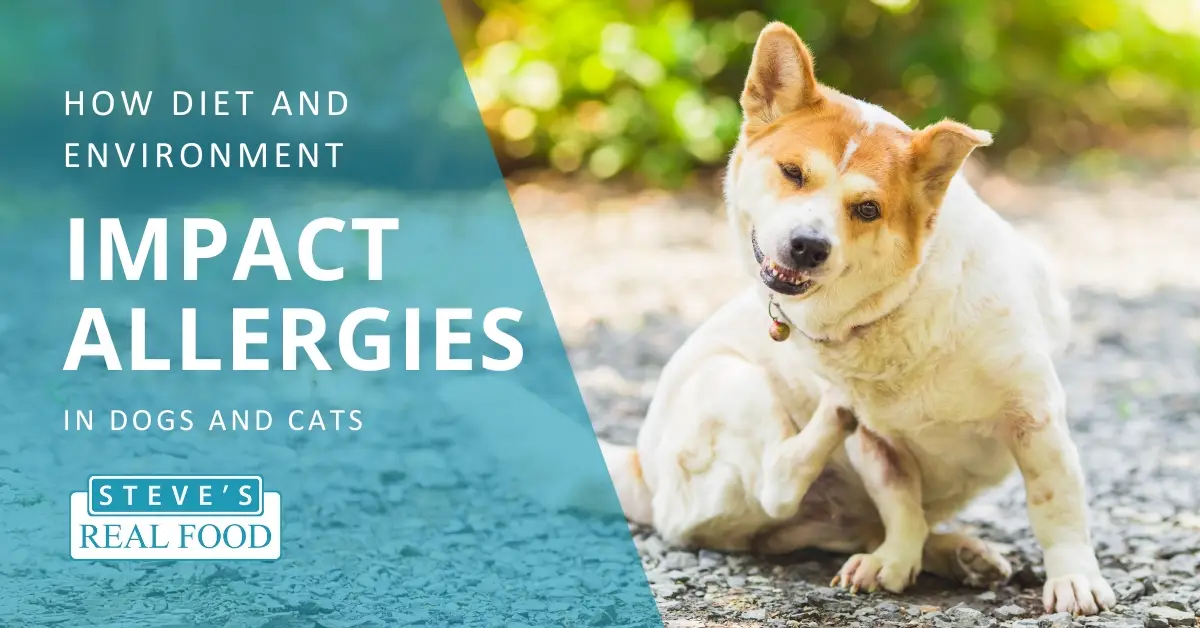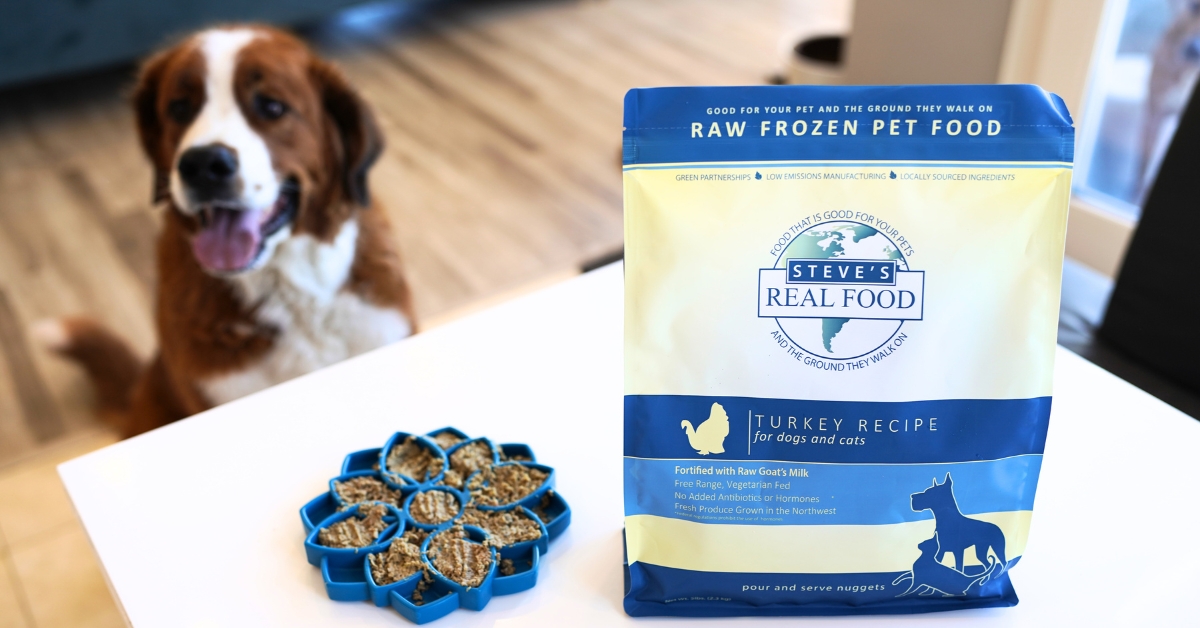Does Your Pet Have Allergies?
Allergies in pets are often misunderstood and can lead your pet down a path to a diminished existence. Limited ingredient diets, allergy medications, and, at their worst, injections or prescription medications with hefty side effects can reduce allergy symptoms but don’t address the root cause. Several of the common medications work by shutting down the immune system partially or entirely, which is not a good long-term solution, as it may increase the risk of infections or cancer.
What is an Allergy?
An allergy, simply put, is an overreaction or hypersensitivity to a typically harmless thing. Allergy symptoms pull double duty, letting you know there’s an issue and working to expel the “intruders.” Inflammation, itching, swelling, runny nose, sneezing, teary eyes, coughing, and even diarrhea all drive potentially harmful particles out of the body and communicate a problem. These reactions are necessary responses by the immune system, but sometimes it reacts to things it shouldn’t or overreacts to small threats with big symptoms.
Why is the immune system misidentifying threats and overreacting? And more importantly, how do we help our pets feel better and live richer, more comfortable lives?
Here’s the exciting bit: allergies are not always permanent. A dog being genuinely allergic to chicken and reacting to chicken every time he eats it are two different things. There can be a genetic or physiological component, but more often than not, it’s an immune system issue you can improve.
In a survey of 632 dogs conducted by the University of Helsinki, over 90% of dogs suffering from skin or digestive issues recovered after changing to a fresh food diet.
But that’s not always the whole story. So, where do we start?
First, we remove or minimize exposure to whatever is making him uncomfortable. Doing so will help us soothe the discomfort as soon as possible and give his body a break to work on the next step: addressing the root of the problem. Often, it isn’t one allergen causing all the discomfort, although repeated exposure over time can sensitize your pet’s immune system, making reactions from certain things more visible.
Common Allergens for Dogs and Cats
- Dust Mites: helpful for recycling materials back into the ecosystem, like skin cells that we’ve left lying around, but their poop isn’t pleasant for the body. A decent percentage of dust is dust mite poo.
- Storage Mites: if you’re feeding dry pet food, there’s a great chance it is home to thousands of storage mites. They’re ubiquitous in the environment, but kibble tends to be a favorite breeding ground/food source/bathroom, and they find their way to it the moment you open the bag. A 2008 study by Univet at the Universitat Autonoma de Barcelona found that within five weeks of being opened, 9 out of 10 bags of dry food were contaminated with storage mites. One of the bags came with mites sealed inside already. Again, their poo is irritating.
- Pollen: Trees, flowers, and grasses all release pollen. High levels can make anyone uncomfortable, but healthy pets should be able to handle everyday levels. After all, dogs and cats have only been living indoors for a few seconds on an evolutionary scale.
- Synthetic Fabrics: Many pet beds are made of synthetic fibers that don’t breathe like natural materials, leading to microbial growth that can cause or exacerbate itchiness. Switch out these synthetic fibers for natural counterparts, like hemp or cotton.
- Synthetic Vitamins and Minerals: Many pet foods, including limited ingredient foods, are high in synthetics to provide essential vitamins and minerals. Just because they’re human-made doesn’t mean they get a free pass in the body. They can cause an allergic response just as well as any meat protein.
- Proteins: Some animals may become sensitive to specific proteins, especially if inflammation has damaged their gut. Often caused by a heavily processed diet, the damage allows undigested food particles and proteins to escape the gut into the rest of the body. The immune system labels that protein as a “foreign invader,” so it causes an immune response whenever it’s eaten.

- Insect Bites: fleas are a great example. The flea’s saliva can cause an allergic response that can itch long after the flea has happily hopped away to lay some eggs under the couch.
- Mold Spores: The immune system has a point here. Mold spores can be problematic for overall health, depending on the mold.
The goal is not to completely eradicate all of these. That isn’t realistic, and besides, some exposure is necessary so the immune system can learn what is dangerous or pathogenic and what is benign and not worth reacting to. The whole system relies on balance. That’s where food and gut health come in.
Common Allergy Symptoms in Dogs and Cats
Skin Issues
- Itchiness
- Flakiness or Dandruff
- Excessive Shedding or Hair Loss
- Swelling or hives
- Hot Spots or Rash
- Excessive Licking
- Chewing Paws or Skin
- Redness Between Toes
Digestive Problems
- Loose Stool or Diarrhea
- Vomiting
- Abdominal Discomfort
- Sensitivities to Ingredients
- Anal Gland Issues
Eyes & Ears
- Puffy or Red Eyes
- Eye Discharge
- Itchy or Smelly Ears
- Chronic Ear Infections
- Head-Shaking
Respiratory
- Sneezing/wheezing
- Coughing
- Runny Nose
- Difficulty Breathing
How Does Food Relate to Allergies?
In a 2021 study at the University of Helsinki, researchers found that puppies who consumed 20% or more of their diet as raw foods saw significantly fewer skin issues than those who ate a wholly processed diet.
Chart A shows the relationship between dogs who reported allergic or nonallergic skin symptoms vs how much of their diet was raw food. Notice the sharp dropoff in symptoms with the inclusion of raw foods. https://onlinelibrary.wiley.com/doi/full/10.1111/jvim.16211
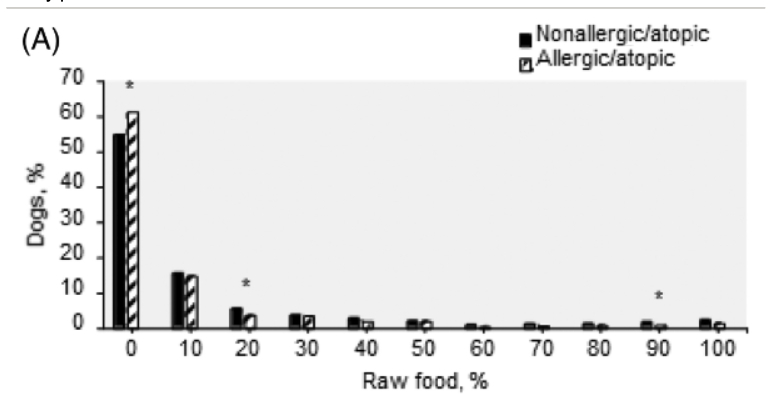
The study authors noted:
“Raw organ meats are dense in vitamins, minerals, and trace minerals and are also a good source of high-quality protein and fat (USDA Food Composition Database). Since some of these nutrients are heat-sensitive, especially the vitamins, offering organs raw to puppies allows them to get the maximum nutritional value. Moreover, raw organ meats as a raw meat-based foods are a good source of beneficial bacteria which may help puppies develop a healthy gut microbiota.”
(Puppyhood diet as a factor in the development of owner-reported allergy/atopy skin signs in adult dogs in Finland https://onlinelibrary.wiley.com/doi/full/10.1111/jvim.16211)
70-90% of your pets’ immune systems reside in their gut, and everything they eat passes through. The gut is like an analyzing chamber, creating a microscopic view of the world outside and educating the immune system. Pollen, dust, spores, bacteria, viruses, and fungi all end up in the gut, where the immune system can closely examine it. In an animal with a thriving community of microbes in their gut – also known as their gut microbiome – the body works with the good microbes to decide what is friend, foe, or not worth noticing. This healthy symbiotic communication reduces the chance of the immune system overreacting to potential allergens and other benign substances.
However, everything gets a little screwy in pets with an unbalanced gut microbiome (known as dysbiosis). Several things are happening here:
- Loss of communication between microbes and the immune system: If the right microbes aren’t thriving in the gut, the immune system loses an essential tool for differentiating between threats and harmless particles. In a 2004 study published in The Journal of Immunology on mice with peanut allergies, the test mice had a genetic issue that damaged one of the types of receptors in their gut that microbes use to talk to immune cells. These mice were susceptible to peanut allergy, with the same symptoms seen in humans with peanut allergies. Some would even go into anaphylaxis. The researchers also had a group of control mice with no peanut allergies. When they had their gut bacteria wiped out, these mice also became susceptible to a peanut allergy. The microbes were no longer there to signal that the peanuts were harmless, so the immune system reacted. An allergy was created. In a more recent related study published in Nature Medicine in 2019, researchers took gut microbes from two groups of human babies – one group had a milk allergy, and one did not. They introduced microbes from each baby into the two groups of sterile-gut mice. The mice that got microbes from healthy babies gained protection from milk allergies, and the ones that got microbes from milk-allergic babies showed susceptibility to a milk allergy.
- Gut Inflammation and Leaky Gut Syndrome: The gut lining is made of trillions of tiny fingers called villi and microvilli. They allow fully digested food and beneficial compounds to cross into the bloodstream to be circulated and used throughout the body. A thin layer of mucus protects these villi. When the microbes in the gut become unbalanced, they damage the mucosal lining and start to irritate and inflame the villi. Not only does this keep the villi from absorbing nutrients properly, it also enlarges the gaps between them, allowing undigested particles of food, bacteria, and other things into the bloodstream. This condition is called leaky gut syndrome. Potential causes are eating a heavily processed, species-inappropriate diet, antibiotic use, toxins, etc. When undigested food particles, say chicken proteins, are allowed to enter the bloodstream, the immune system recognizes that they shouldn’t be there and attacks the intruders. This immune reaction can cause itching, inflammation, and other discomfort. The immune system also goes on high alert, meaning it will react with life-or-death seriousness anywhere it encounters those chicken proteins – even in the gut where they belong.
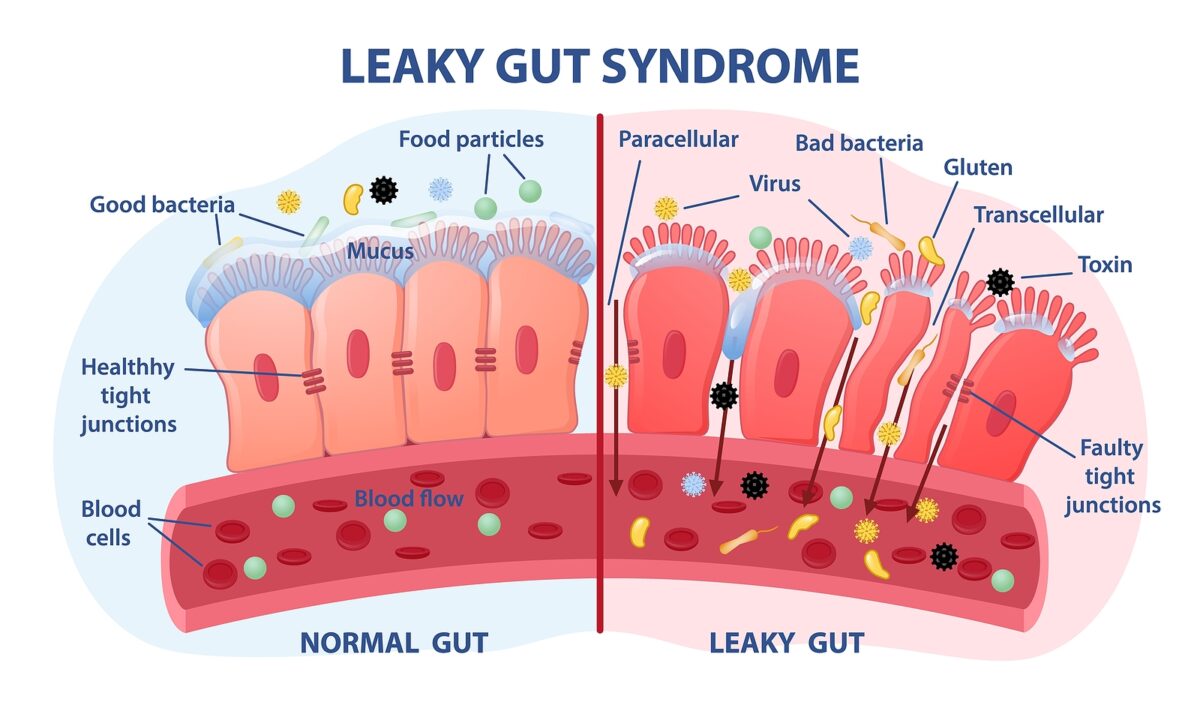
- Loss of microbiome diversity – In addition to communicating with the immune system, the microbes that live in and on your dog or cat provide several types of protection. They crowd out pathogenic or irritating microbes, forming a shield. They create beneficial compounds that nourish your pet’s cells and aid their immune system. They play a significant role in digestion, hormone production, and much more.
In a healthy animal, hundreds or even thousands of different types of bacteria, fungi, and viruses live in and on their body. This diversity is vital to maintaining a thriving microbiome.
When the microbiome becomes unbalanced, diversity plummets. Important jobs may go undone, and less desirable microbes can grow unchecked. In a 2022 study by the University of Zurich, dogs with skin allergy symptoms also had less diverse gut microbiomes. In another 2014 study published in PLOS ONE, researchers compared the skin microbes of healthy dogs and dogs with skin allergies. They found similar results: the healthiest dogs had the richest, most diverse microbiomes.
To sum it up, many allergy symptoms stem from an out-of-whack immune system related to an unbalanced gut. If you’d like to dive deeper, check out these interviews with exceptionally brilliant experts: Dr. Odette Suter “The Microbiome,” and Julie Anne Lee of Adored Beast “Allergies in Pets.”
The Best Diet for Allergy-Prone Dogs & Cats
Cats are obligate carnivores, which means they have an obligation to their body to eat a carnivorous diet. Left to their own devices, they would prefer to eat a diet of fresh, raw prey that they hunt and kill. Steve’s Real Food Prey Model Diet and Quest Cat Food are 95% fresh raw meat, organ, and bone and 5% natural supplements like kelp, chia seed, and goat milk.
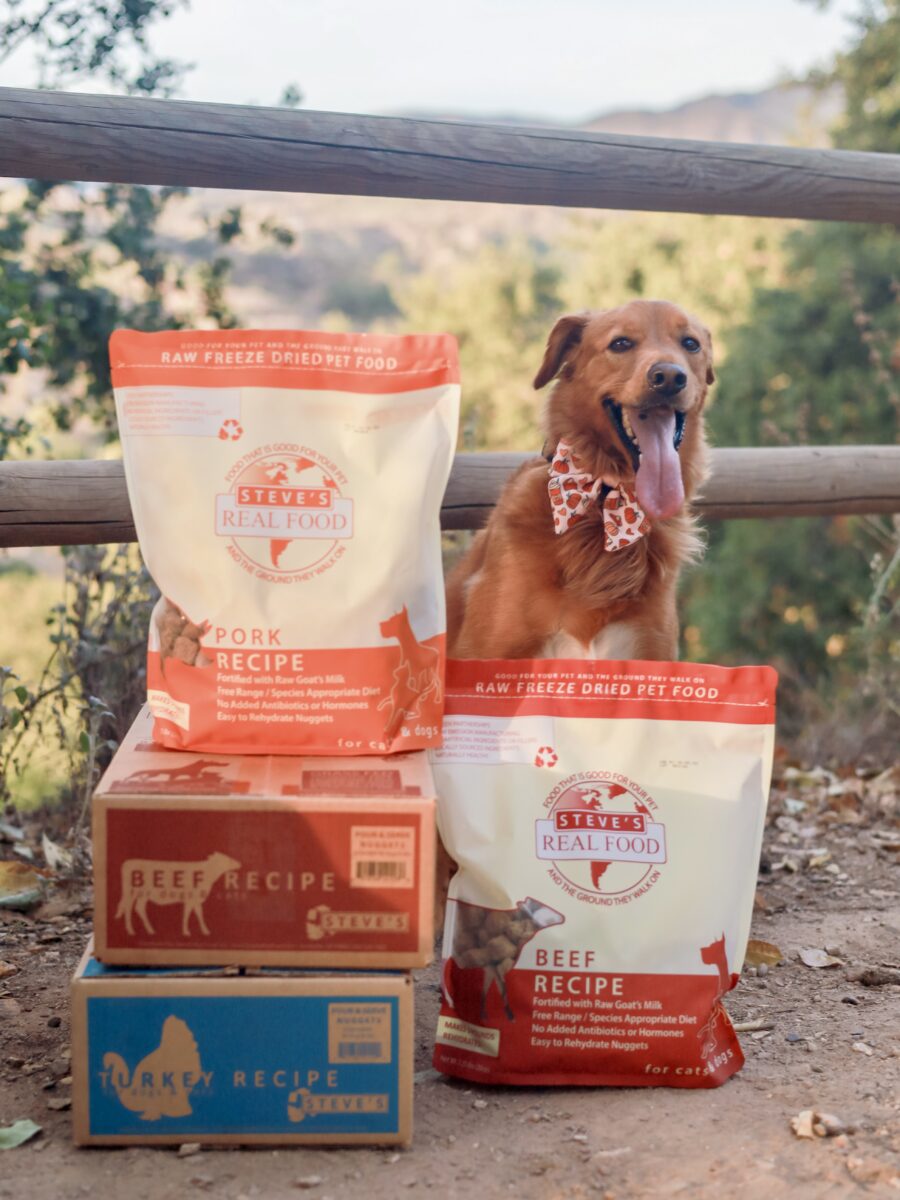
All the nutrients should come from natural foods, which is essential for encouraging microbiome diversity because it means no microbes are out of a job. When synthetic vitamins and minerals are relied on to balance and complete a recipe, the microbes that break down or form those compounds don’t have anything to do. More importantly, they don’t have anything to eat, and so they decline in numbers or disappear altogether. By providing real food to your dog or cat, you also provide food and jobs to the trillions of microbes that work to keep them healthy and strong. In a 2022 study at the Carlson College of Veterinary Medicine, researchers discovered that dogs who ate a fresh diet saw an increase in skin microbiome diversity – an essential step in helping dogs with skin allergies.
Rotate the proteins in your pets’ diet. Eating the same thing for too long leads to boredom and food monotony and may even cause intolerances and sensitivities. For a healthy pet, you can switch flavors whenever you open a new bag to keep things fresh and interesting. More sensitive pets may require a slower transition between flavors the first time they try a new one.
The goal of feeding an ideal, species-appropriate diet is to eventually reduce or overcome sensitivities by building a robust, well-educated immune system.
Ingredients to Avoid
- Preservatives – Common in processed pet foods, they allow that bag to sit on a shelf with no refrigeration for over a year. Unfortunately, they also harm the microbiome. Preservatives can slow or disable microbes and don’t stop working once your pet eats them.
- Synthetic Vitamins and Minerals – Dr. Judy Morgan states, “Synthetic nutrients can behave differently in the body than their natural counterparts. In some cases, the animal’s body may look at the synthetic vitamin as a foreign body and not recognize it as food.” You can read more about her take on these food additives here.
- Mycotoxins – Mold often grows on grains and legumes before harvest or during storage. These molds create potent toxins that can be carcinogenic, cause damage and discomfort, suppress the immune system, and disrupt the microbial balance. Their effects can be sudden or cumulative over the years. A study published in 2019 by MDPI reported that 98.6% of USA-grown corn tested positive for mycotoxins.
- Pesticides – Pesticides can damage microbial diversity when used on crops grown for pet food.
- Other Inappropriate Ingredients – Avoid high-sugar and high-carbohydrate diets. Dextrose, corn syrup, maltodextrin, potatoes and sweet potatoes, peas, chickpeas, lentils, and grains are high in carbohydrates and can feed microbes like yeast that can cause or increase irritation.
Steps for Allergy Relief in Dogs and Cats
Medications and prescription pet foods with predigested proteins designed to alleviate the symptoms do not address the root cause of the issue. It’s like taking off your sweater because the house is on fire. Sure, you’re not as hot, but there’s a bigger problem you should probably address.
Our goal is to reduce discomfort now and improve the immune system response over time. Soothe the gut, support the body to heal itself, and diversify the microbiome.
- Allergy Tests: For any pet experiencing severe allergy symptoms, an allergy test can be a good place to start. Again, we’re not looking to avoid these specific allergens permanently but rather give the body a break from them as we work on balancing the immune system. Nutriscan by Dr. W. Jean Dodds was highly recommended by several of the experts we interviewed, so if your dog or cat is suffering from persistent allergies, you can start by getting a test done.
- Minimize Exposure to Environmental Allergens: Clean up dust around the house, change your air filters, switch out synthetic fabrics for natural fibers, and look for any mold or mildew growing indoors. The goal here is to reduce the load on the immune system as we work on balance. After spending time outside, be sure to decontaminate. Pollen can hitch a ride indoors on your clothes or your pet’s coat and continue causing issues. Wipe down your pet with a damp cloth whenever they come in from outside, paying special attention to the face and feet. Pollen counts tend to be highest earlier in the day and on windy days, so save walks for later in the day if the weather allows and find ways to have fun indoors instead.
- Work on Improving the Gut: Feed a species-appropriate diet that is made with whole foods and encourages microbial balance in the gut. Because it discourages diversity in the gut, if you feed a highly-processed diet, include some fresh raw foods or switch to a fresh diet. Adding probiotic-rich foods like Steve’s fermented Protein Bites can help the gut achieve better balance, providing a mix of pre-, pro-, and postbiotics. It’s important to note that diet is a huge, but not the only, piece of the puzzle. For many pets, relief will require combining several of these steps. Stress can actually be a significant factor in gut health, so reduce stress in your pet’s life during this time.
A holistic veterinarian will be helpful for pets with severe sensitivities, suspected yeast overgrowth, or leaky gut.
Adored Beast Apothecary also has a Leaky Gut Protocol and a Yeasty Beast Protocol available for dogs and cats.
- Naturally Soothing Additions to the Bowl – Reishi mushrooms can help balance the immune system, and you’ll want a blend of fruiting body and mycelium. Blueberries and parsley contain Quercetin, which is a natural antihistamine. Herbal teas can be effective. “The Natural Pet Doctor, ” Dr. Katie Woodley,” created this video. Herbal Teas for Pet Allergies.
- Don’t Use Harsh Shampoos – Go for plain water or gentle natural products instead. We’re working to restore healthy skin function; harsh cleansers will strip away natural oils. A daily wipe-down with a damp washcloth can help reduce allergens on the coat.
- Be Proactive and Plan for Next Allergy Season – Although some pets may be able to leave allergies in the past, some will suffer from seasonal flares for the rest of their lives. It’s crucial to get ahead of allergy season and ensure your dog or cat is strong and well-supported before the pollen starts making them miserable.
Could it be Something Other than Allergies?
Though we’ve addressed the root cause of many allergies, there is no one-size-fits-all solution. Some conditions and diseases may appear as allergy symptoms, so if you’re concerned, consult with your holistic veterinarian, who will take a whole-body approach to wellness. You can locate a holistic vet on the American Holistic Veterinary Medical Association’s website.

